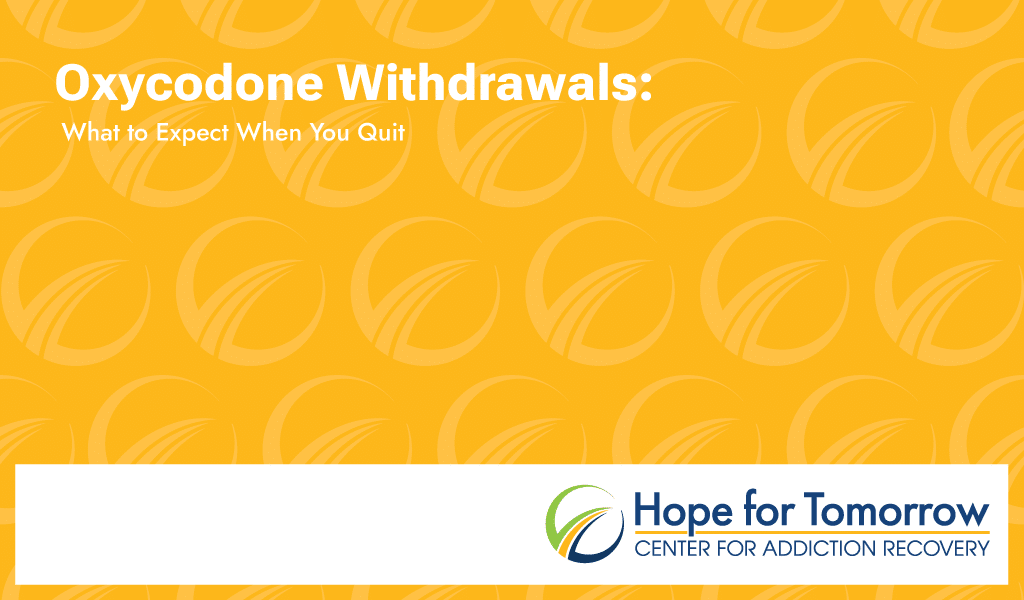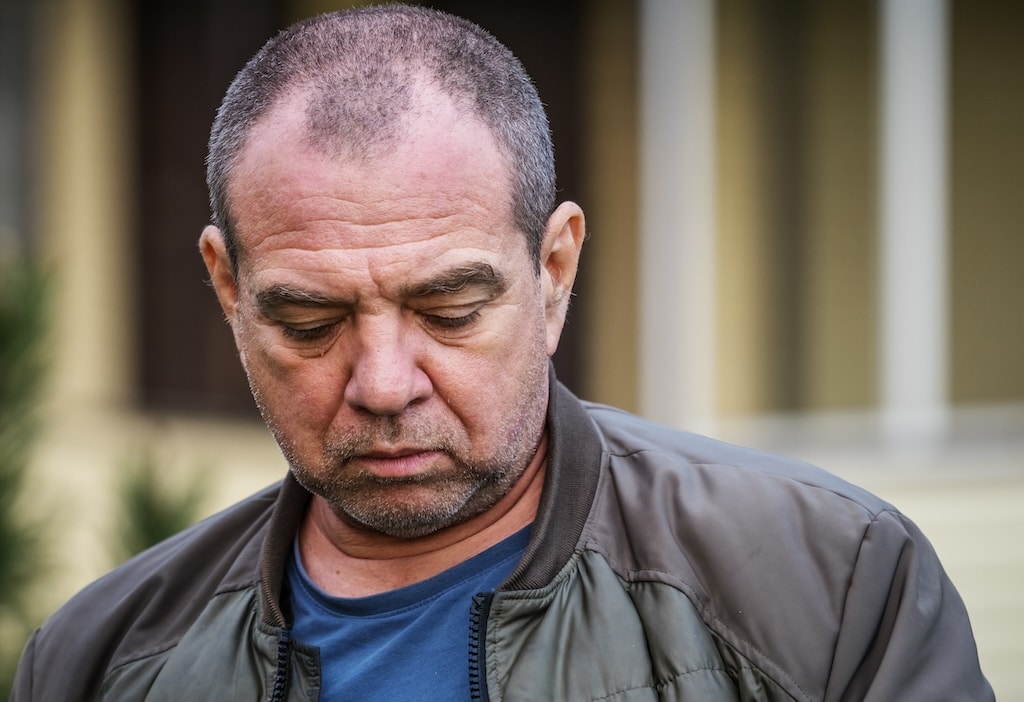

Your son has been taking oxycodone for years, and he wants to get clean. He decides one day to quit, cold turkey, and you stay with him to support him.
That night, the chills begin. Your son is on the bathroom floor, vomiting in the toilet, and you have a blanket around him, trying to help him stay warm. Then the muscle twitches begin; soon his whole body aches, and he’s running a fever. He feels jittery and can’t sleep. You’re wondering whether you should call 911 or wait it out.
Whether you’ve been the parent, the one on the bathroom floor, or another family member or friend, we see you and want you to know that there is help available. While Oxycodone no longer drives overdose deaths in West Virginia, it still killed 57 West Virginians from overdoses in 2021. Quitting takes strength and requires high-quality care. At Hope for Tomorrow, we have practitioners who will walk you through every step of detox and withdrawal. Withdrawal can be painful, but it’s the first step to reclaiming your life.
You will experience oxycodone withdrawal if you’ve been taking oxycodone for a few weeks or more and you suddenly decrease your dosage or stop completely.
A look inside your brain helps visualize the process of withdrawal.
Oxycodone binds to many neuroreceptors in your brain, including ones in your brain’s reward system that release dopamine. It also travels to a region at the base of the brain that controls breathing, wakefulness, blood pressure, and general alertness. When it binds to these receptors, oxycodone suppresses these functions and causes the typical symptoms of an opioid — slow breathing, drowsiness, and low blood pressure.
As you continue to take oxycodone, your brain receptors don’t respond to the substance as strongly, and you might increase your intake to get the same amount of dopamine and relaxation from the substance. In turn, your body makes more of the chemical needed to keep you awake and breathing to counteract the blockade made by the oxycodone.
If you decide to stop taking oxycodone, however, the extra chemicals made by your brain to keep you awake and breathing end up being the reason you feel so sick as you detox from the substance. The overproduction of this chemical causes anxiety, diarrhea, jitters, and muscle cramps until the body learns that the heightened amount is no longer needed. Your brain will also experience a dip in dopamine when you stop taking oxycodone, causing irritability and/or depression. Withdrawal symptoms perpetuate the cycle of opioid use disorder because the discomfort can easily cause a return to use. With the right support and oxycodone treatment in place, however, withdrawal symptoms can be managed, and your brain’s chemical production will return to normal.

Here are some of the symptoms you can expect as you go through withdrawal from oxycodone:
Oxycodone withdrawal is not inherently fatal, but withdrawal symptoms can be dangerous if not treated properly. Losing fluids rapidly without drinking water puts you at risk for dehydration, which can be deadly.
Withdrawal is a very uncomfortable process to go through alone and can be dangerous. Contact your medical provider while going through withdrawal, or call us. Support is only a phone call away.
The severity and length of an oxycodone withdrawal will depend on how long you have been taking it, how often you use it, how you use it, and your overall health. Oxycodone withdrawal symptoms tend to begin 8 to 24 hours after your last dose and last 4 to 10 days.
The long-term symptoms of withdrawal may last for six months after the initial intense week of symptoms. You may feel generally unwell and have strong cravings for oxycodone. Getting tested and treated for mental health conditions after going through detox and withdrawal will reduce your risk of relapse. After you stop taking a substance, you often must face the problems or situations that triggered your chronic use in the first place. Therapy groups, outpatient counseling, day hospitalization, and inpatient treatment can be key to the recovery process.
If you or someone you know is contemplating suicide, call or text 988 for immediate, free support. You can also call 911 or go to the emergency room. Withdrawal symptoms can be harrowing, but you will come out from the other side with perseverance and support. There is hope in recovery.
Getting the oxycodone out of your system can take days of uncomfortable symptoms because of the overproduction of stress hormones and adrenaline in your body and the lack of dopamine. The need for relief can be so strong that you go right back to taking oxycodone. To prevent a return to use and help patients get back to their everyday lives, medical practitioners often prescribe medications that aid with the detox process.
Methadone: Methadone takes away cravings and withdrawal symptoms by binding to the same receptors in the brain as oxycodone, but it has a milder effect than oxycodone. It can be used as a maintenance drug for years or reduced slowly until the patient is no longer dependent. It regulates the body’s stress response that is triggered during withdrawal, minimizing the chance of relapse and allowing the patient to return to daily life activities.
Buprenorphine: This medication also manages cravings long-term and can help shorten detox but is slightly safer than methadone because an increased dosage of buprenorphine causes withdrawal symptoms, making it less likely to be misused. Buprenorphine is often combined with naloxone (Suboxone). This creates a ceiling effect, making you less prone to overdose.
Other medications: While methadone and buprenorphine are the main medications that make withdrawal symptoms more bearable and make it more possible to wean off of an opioid, there are others that help with the symptoms of withdrawal. Clonidine helps with anxiety, muscle aches, agitation, runny nose, and cramping. Naltrexone can stop a return to use by reducing cravings and blocking the effectiveness of opioids on the brain. It also causes immediate and severe withdrawal symptoms if taken with opioids in the system.

Going through withdrawal is not for the faint of heart. A return to use is common. If you or someone you love is living with a substance use disorder, and you’re tired of the seemingly never-ending cycle, you are not alone.
Everyone in recovery deserves empathy and individualized care. At Hope for Tomorrow, we prioritize patients’ needs.
Hope for Tomorrow provides residential and outpatient care for people experiencing addiction at our locations in Point Pleasant and Beckley, West Virginia. We use medication-assisted treatment in combination with cognitive behavioral therapy, family, group, and individual counseling. Our patients range from pregnant women to veterans to couples to people with other medical or mental health conditions. We take everyone. Call us today at 877-679-8162.
Treatment today for a brighter tomorrow.
How long do symptoms last in oxycodone withdrawal?
Severe physical symptoms can last 4 to 10 days. A general feeling of illness and cravings for oxycodone can last six months after the initial withdrawal symptoms.
Can you die from oxycodone withdrawal?
Death from oxycodone withdrawal is not likely, but it can happen if a patient who is throwing up is not monitored for dehydration or choking on vomit. If vomit gets in the lungs, the patient can get a lung infection, and if dehydration is severe enough, it can lead to heart failure.
How do I handle anxiety and depression after detoxing from oxycodone?
Taking care of your mental health after detoxing from oxycodone is a major factor in preventing relapse. You can see a psychiatrist to explore medication options and a therapist to process the complex emotions after coming off of oxycodone. Going to group therapy sessions and building or maintaining a community of supportive people can also aid in reducing anxiety and depression symptoms after detoxing.